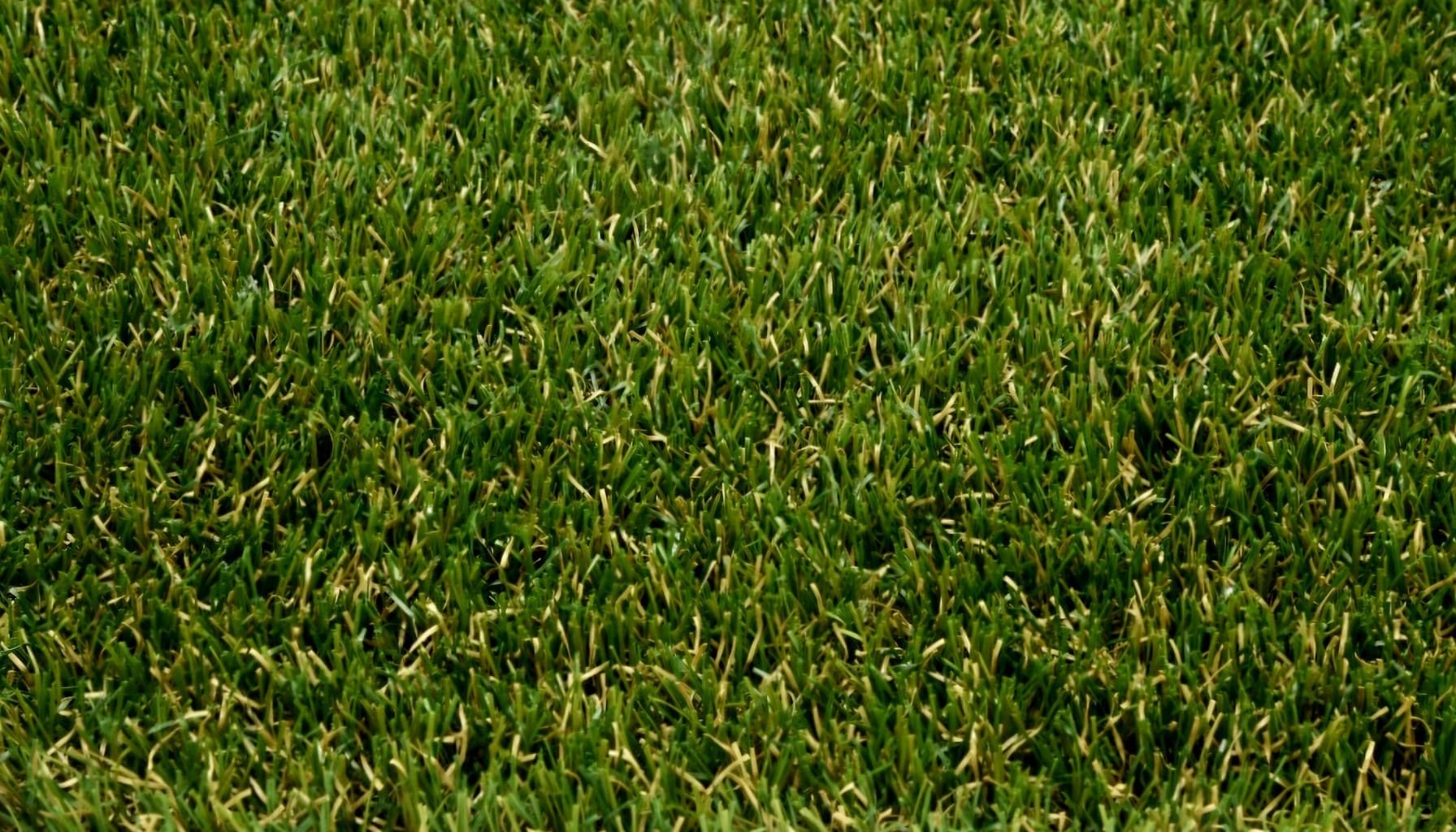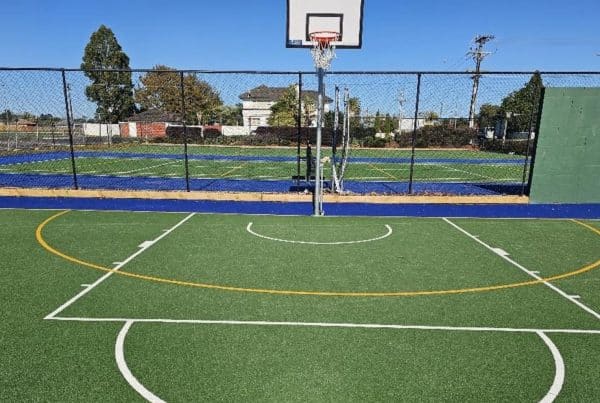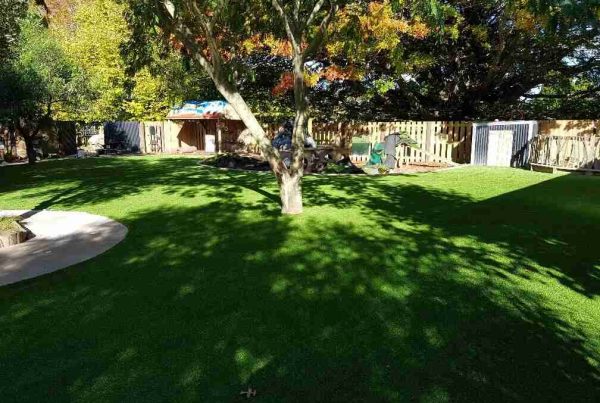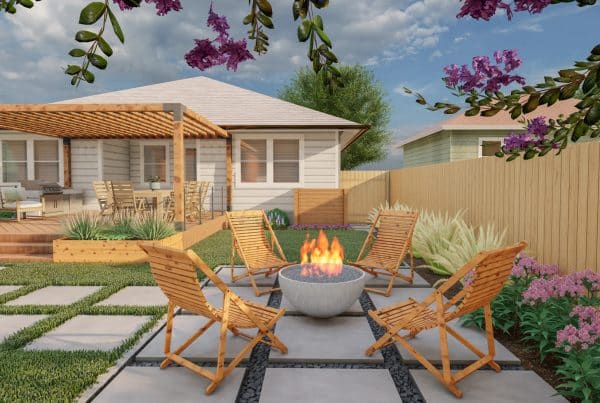Synthetic turf in NZ has become increasingly popular for its low maintenance and year-round green appeal. At Unreal Lawns & Courts, we’ve seen a surge in demand for artificial grass solutions across residential, commercial, and sports applications.
Choosing the right type of synthetic turf is essential for achieving the best results for your specific needs. This guide will help you navigate the various options available and make an informed decision for your property or project.
Types of Synthetic Turf Available in NZ
At Unreal Lawns & Courts, we offer various synthetic turf options to suit different needs and preferences in New Zealand. Understanding these options will help you select the best choice for your property or project.
Short Pile Artificial Grass
Short pile artificial grass (typically 20-30mm in height) excels in high-traffic areas. It provides a safe, soft, clean, and dry playing surface all year round, in addition to its attractive appearance and low maintenance qualities. This turf type creates a firm, stable surface perfect for activities that require quick movements or the use of wheeled equipment.
Medium Pile Artificial Grass
Medium pile grass (ranging from 30-35mm) strikes an optimal balance between realism and practicality. It serves as our most versatile option, suitable for residential lawns, landscaping, and light sports use. This type closely replicates the look and feel of natural grass while offering improved durability and minimal maintenance requirements.
Long Pile Artificial Grass
For a lush, luxurious appearance, long pile artificial grass (40mm and above) stands out as the premier choice. It suits ornamental lawns, display areas, and spaces where aesthetics take centre stage. While it demands more upkeep than shorter options, it delivers an unmatched natural appearance that can transform any outdoor space.
Specialised Sports Turf
We also provide specialised sports turf designed to meet specific performance standards for various athletic activities. These turfs undergo engineering to provide optimal ball roll, bounce, and player comfort. You’ll often find them in tennis courts, cricket pitches, and multi-sport facilities (where versatility is key).
Factors to Consider
When you select synthetic turf NZ, consider factors like foot traffic, intended use, and local climate. For instance, areas with high UV exposure require turf with enhanced UV resistance to prevent fading. Regions with heavy rainfall need proper drainage capabilities to avoid water accumulation.
The quality of infill and backing materials also plays a significant role in the turf’s performance. Sand infill helps maintain blade structure, while rubber infill enhances shock absorption for sports applications. A strong, permeable backing ensures proper drainage and turf stability.
Maintenance requirements also differ among turf types. While all synthetic turf requires less maintenance than natural grass, different types may need varying levels of care to maintain their appearance and performance over time.
As we move forward, let’s explore the specific factors you should consider when choosing the right synthetic turf NZ for your needs. These considerations will help you make an informed decision that aligns with your unique requirements and preferences.
Factors to Consider When Choosing Synthetic Turf NZ
Intended Use and Traffic
The primary purpose of your synthetic turf will influence your choice. For residential lawns, a medium-pile grass (30-35mm) often provides the best balance of aesthetics and durability. Commercial spaces or sports fields require more robust options. Short-pile grass (20-30mm) suits high-traffic areas, offering stability and resilience.
Sports applications often need specialised turf. Tennis courts require a dense, short-pile surface for optimal ball bounce, while soccer fields need a slightly longer pile to cushion falls and allow for sliding tackles. The Synthetic Turf Council reports that polyethylene grass dominates 70% of residential installations due to its balance of durability and softness.
Climate Considerations
New Zealand’s diverse climate demands careful turf selection. Areas with high UV exposure (such as Auckland or Northland) require UV-resistant turf to prevent fading and maintain colour vibrancy over time. Coastal regions benefit from salt-resistant varieties to withstand sea spray.
Rainfall also plays a critical role. Regions like Wellington or the West Coast, with high annual rainfall, need excellent drainage. Try to find turf with a perforated backing that allows water to flow through quickly. This feature prevents waterlogging and extends the turf’s lifespan.
Durability Requirements
Expected foot traffic and usage intensity should guide your choice. A backyard that hosts frequent gatherings or has active children and pets will require more durable turf than a rarely-used front lawn.
Nylon fibres offer the highest durability but come at a premium price. Polyethylene provides a good balance of durability and cost-effectiveness for most residential applications. The face weight of the turf (measured in ounces per square yard) indicates durability. For residential use, try to select a minimum of 60 ounces per square yard.
Aesthetic Preferences
The appearance of your synthetic turf NZ plays a significant role in your satisfaction. Modern synthetic turf comes in various shades of green, and some even incorporate brown thatch to mimic natural grass more closely.
Consider how the turf will blend with your existing landscaping. A lush, dark green might look out of place in an area where natural grass tends to be lighter or more yellowish. Some manufacturers offer samples, allowing you to see how the turf looks in your specific environment before making a decision.
Budget Considerations
Initial costs for synthetic turf can be higher than natural grass, but it’s important to consider the long-term savings. The cost of artificial grass in New Zealand ranges from NZD $30 to $60 per square meter, depending on the quality and type of grass chosen.
While it might be tempting to opt for the cheapest option, quality often correlates with price. A higher upfront investment in a premium product can result in lower maintenance costs and a longer lifespan, providing better value over time.
When comparing quotes, look beyond the per-square-meter price. Consider the total installation cost, including base preparation, infill materials, and edge finishing. Some providers might offer seemingly low prices but cut corners on installation steps, leading to problems down the line.
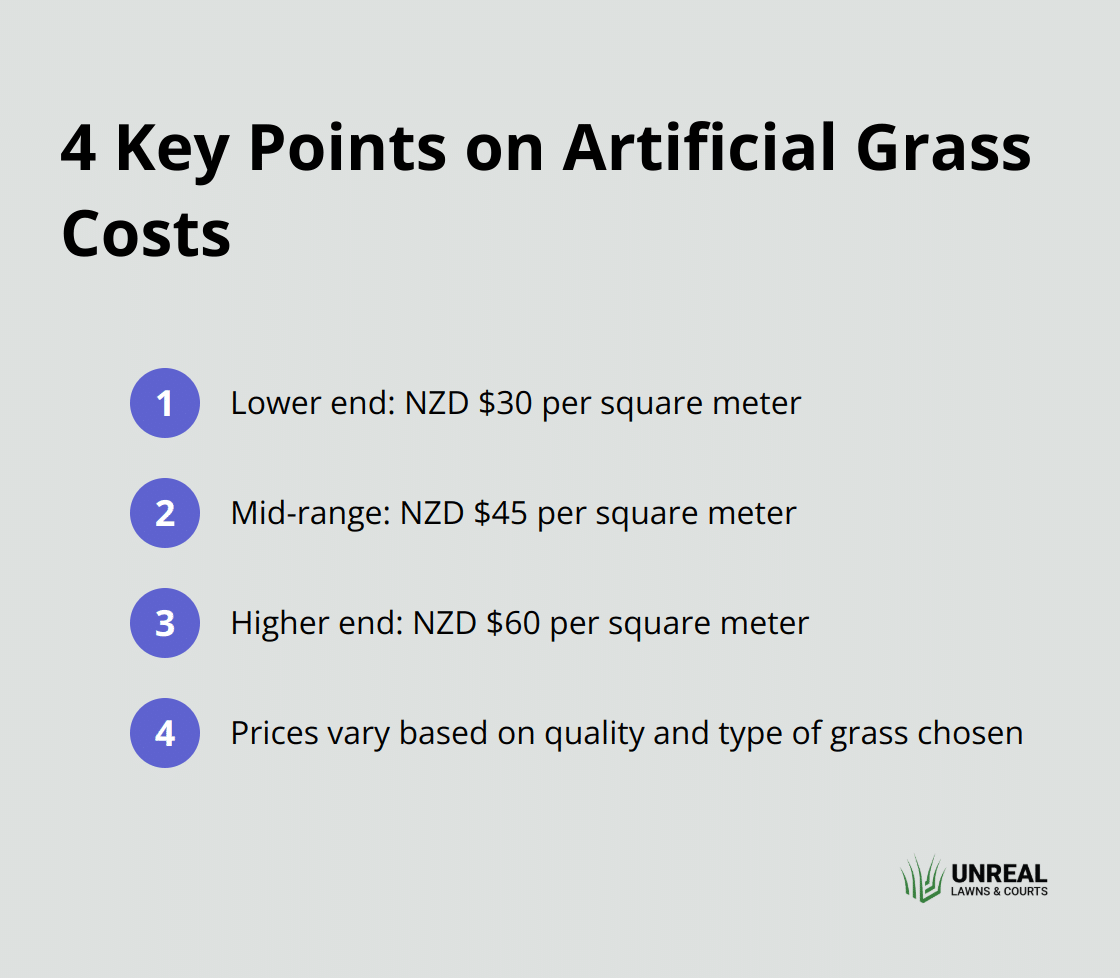
As we move forward to discuss installation and maintenance, it’s important to note that proper installation significantly impacts the performance and longevity of your synthetic turf. Let’s explore the best practices for installing and maintaining your new synthetic lawn.
How to Install and Maintain Synthetic Turf NZ
Professional Installation Process
Professional installation of synthetic turf offers numerous benefits for NZ properties. Installers begin by preparing the site, removing existing vegetation to 100mm, grading for proper drainage, and compacting the soil. They add a geotextile fabric then a base layer of crushed stone / aggregate and levelled it meticulously to prevent future settling or unevenness.
The synthetic turf NZ is then rolled out, measured precisely, and cut to fit the area. Seams are joined using specialised tape and adhesive, and the turf is secured around the perimeter with a timber edge and staples.
The final step involves applying infill material, such as silica sand or rubber granules, which is spread evenly across the surface and brushed into the fibres. This provides stability, improves drainage, and helps the grass blades stand upright.
DIY Installation Tips
DIY installation requires proper preparation and the right tools. Accurate measurement of the area is essential, and it’s wise to order slightly more turf than needed to account for cuts and waste. Necessary tools include a plate compactor, turf cutter, and power broom (which can often be rented).
When laying the turf, pay extra attention to seam joining. Poorly joined seams can lead to premature wear. Use a carpet kicker to stretch the turf tightly before securing it.
Infill application is another important step. Apply the infill in thin layers, brushing between applications to ensure even distribution. This process helps avoid clumping and ensures the infill settles properly between the grass fibres.
Regular Maintenance
Regular maintenance keeps synthetic turf NZ looking its best. Weekly brushing with a stiff-bristled broom or power broom redistributes infill and keeps grass fibres upright. This is particularly important in high-traffic areas.
For cleaning, use a mixture of mild soap and warm water to remove most stains. Avoid harsh chemicals that could damage the turf fibres. Rinse thoroughly after cleaning to prevent soap residue buildup.
Address spills and stains promptly. Most synthetic turfs resist staining, but quick action prevents substances from setting into the fibres. For stubborn stains, consult the manufacturer’s guidelines or seek professional cleaning services.
Long-term Care
Long-term care involves periodic deep cleaning and infill replenishment. Every 12-18 months, consider hiring a professional service for a thorough clean and to top up the infill material. This maintains the turf’s performance and extends its lifespan.
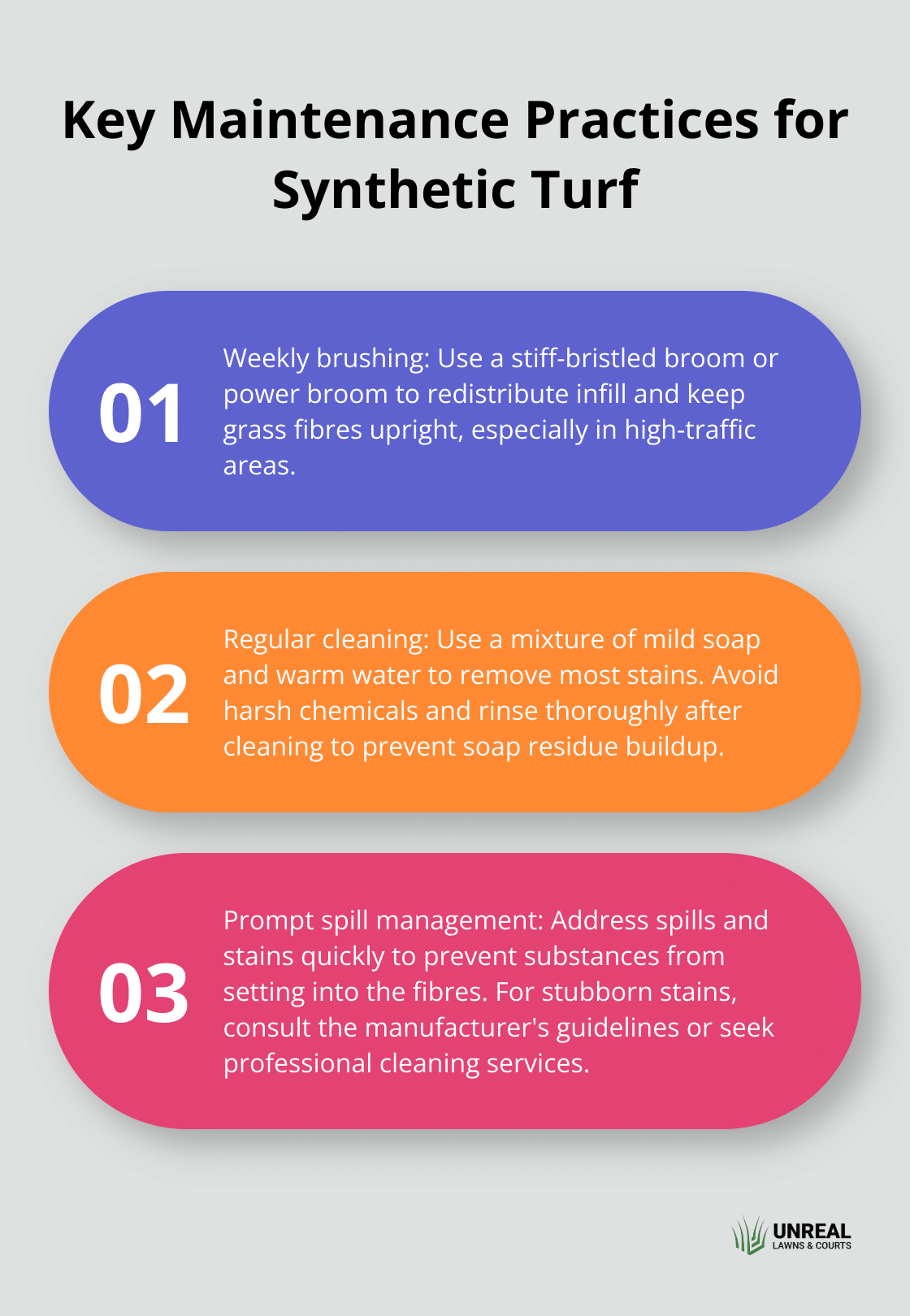
In areas with heavy leaf fall, use a leaf blower or rake with plastic tines to remove debris. Metal rakes can damage the turf fibres and should be avoided.
For repairs, keep leftover turf from the initial installation. Small damaged areas can often be patched using these remnants and seam tape. For larger issues (or if you’re unsure), consult with a professional to ensure proper repair and maintain the warranty.
When choosing synthetic turf, opt for UV-resistant options to prevent fading, select turf with a strong backing for durability, and ensure efficient drainage for pet-friendly and weatherproof use.
Final Thoughts
Synthetic turf NZ offers numerous benefits for property owners. It eliminates regular mowing, watering, and fertilising, saving time and resources while providing a consistently usable outdoor space. The right choice will withstand local weather patterns and maintain its appearance for years, enhancing curb appeal regardless of conditions.
When selecting synthetic turf, consider the long-term value rather than just the initial cost. A higher-quality product often translates to better durability, appearance, and overall satisfaction. Professional installation proves essential for optimal performance and longevity, ensuring proper base preparation, seam joining, and infill application.
For premium synthetic turf solutions in New Zealand, Unreal Lawns & Courts offers high-quality options suitable for various applications. Their expertise in installation makes them a reliable choice for transforming outdoor spaces. Proper maintenance, though minimal compared to natural grass, remains important for preserving your synthetic turf’s appearance and functionality.

